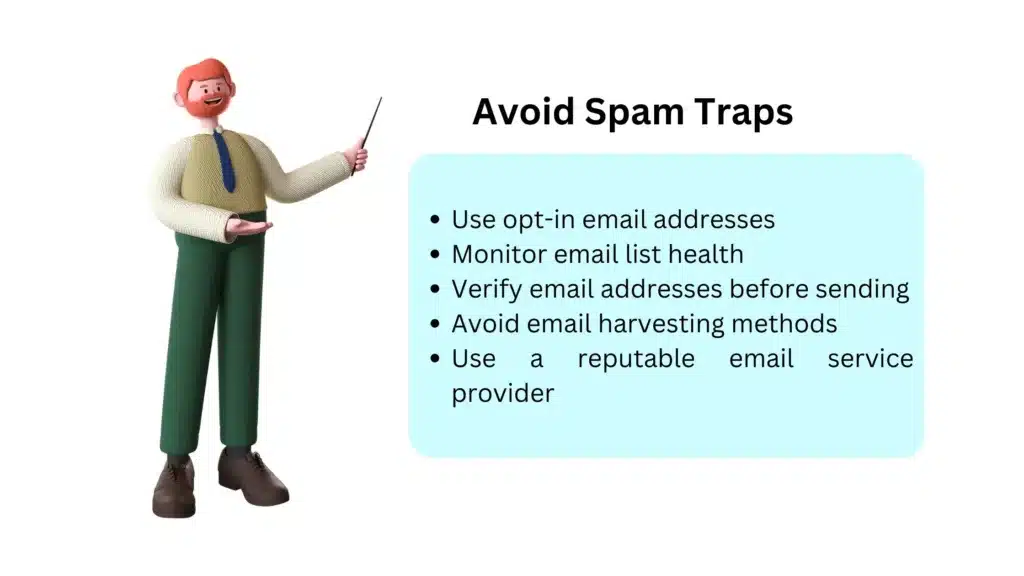Table of Contents
Introduction
Email is an essential part of our daily lives and a crucial tool for communication and marketing. However, it’s also a prime target for spammers who use automated tools to send unwanted messages. In this post, we will explore the spam traps
What are Spam Traps?
Spam Trap definition – A spam trap is an email address that is created solely for the purpose of catching spammers. Spammers often use automated tools to harvest email addresses from websites, forums, and other sources. When these addresses are inactive for a long time, they are typically recycled and turned into spam traps. When a spammer sends an email to the recycled email the respective sender’s IP address is added to a blacklist, and their future emails will likely be marked as spam.
Spam traps are a kind of spam prevention method. Spamming is prevented by ISPs(Internet service providers). Internet service providers and blacklist providers create a trap to catch the spammers and block them. To avoid spam traps always approaches the email best practices.
A spam trap appears as real email addresses which not belong to users but ISPs. The email addresses are just like normal addresses but they are not real end-user.
Types of Spam Trap
There are commonly three types of spam traps –
Recycled Spam Trap
Inactive emails are activated by ISPs to block the senders. Providers use addresses that have been abandoned by users for so long. In emails which have had no activity for a long time, those email addresses get inactivated and those inactive addresses are activated by ISPs or blacklist providers to trace the sender who is spamming.
Pristine Spam Trap
ISPs intentionally spread email addresses on the web through forums, blog posts, websites or any publicly accessible place. So the web scraper can collect and use them. In this way, ISPs catch those spammers red-handed.
Typo Spam Traps
A typo is a term used to describe a typing error, If an email is accidentally sent to an incorrect address, the sender may be subject to penalties, as ISPs may classify the domain as a source of unwanted or unsolicited email (spam) and blacklist it. Additionally, spammers often target random email addresses based on domain names, which may trigger a spam trap. In this scenario, ISPs or blacklisting providers may block the associated IP address and domain to prevent further unwanted emails.
How to Avoid Spam Traps?
By following email best practices. Legitimate senders also face spam traps due to a lack of knowledge about email marketing. A spam trap is very dangerous. It can spoil all your efforts. To become a legitimate marketer follow the below things

Identifying Spam Traps can be a challenging task, but there are a few methods you can use to minimize the risk of sending emails to spam traps:
- Use opt-in email addresses: The best way to avoid spam traps is to only send emails to individuals who have explicitly given you permission to email them. This ensures that the email addresses you are sending to are active addresses.
- Monitor email list health: Regularly monitor the health of your email list by checking for inactive or invalid email addresses.
- Verify email addresses before sending: Before sending emails, verify the email addresses in your list to ensure that they are valid and belong to real individuals. There are various tools available that can help you validate email addresses.
- Avoid email harvesting methods: Spammers often use automated tools to harvest email addresses from websites, forums, and other sources. Avoid using email harvesting methods and ensure that your website’s email addresses are not easily accessible to spammers.
- Use a reputable email service provider: Reputable email service providers use spam trap monitoring and management techniques to help protect your email reputation. By using a reputable provider, you can minimize the risk of sending emails to spam traps.
Things to be in practice to prevent spam traps
- Clean your email list on a regular basis.
- Remove email addresses that cause hard bounces.
- Don’t ever purchase an email list.
- Remove email addresses that have not opened emails for several months.
- Send emails to only opt-in email addresses.
- Don’t spam the subscribers, send them relevant content for what they subscribed to.
- Provide an Unsubscribe option in your email so if they are not interested they unsubscribe easily.
Impact of spam traps on sender reputation
Spam traps can directly impact on sender’s reputation. Reputation decreases if the spam trap hits. Might be possible if ISPs found something serious and then permanently block the respective domain along with all the IPs. Always maintain the sender’s reputation otherwise it leads to a huge loss. Follow the email marketing best practices to get better results. Read more about email deliverability best practices.
Learn about graymail by Hubspot
